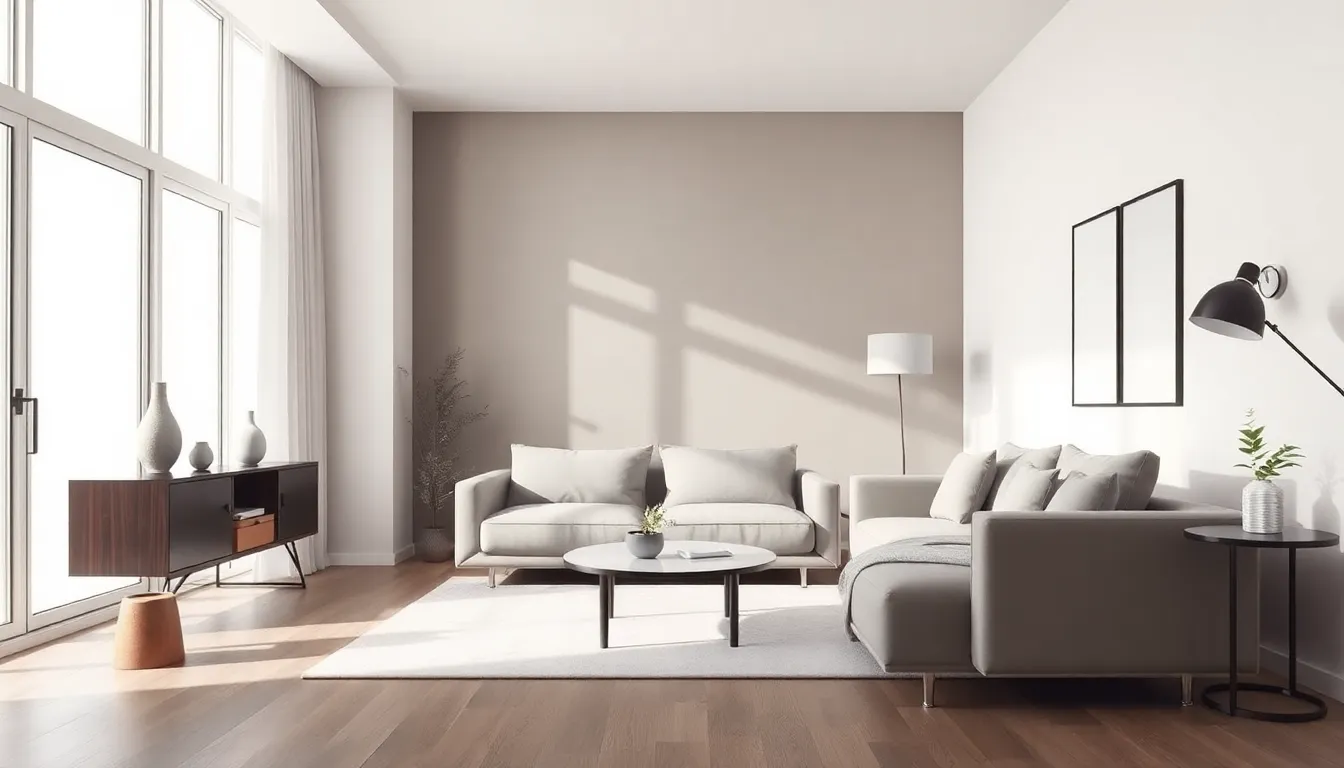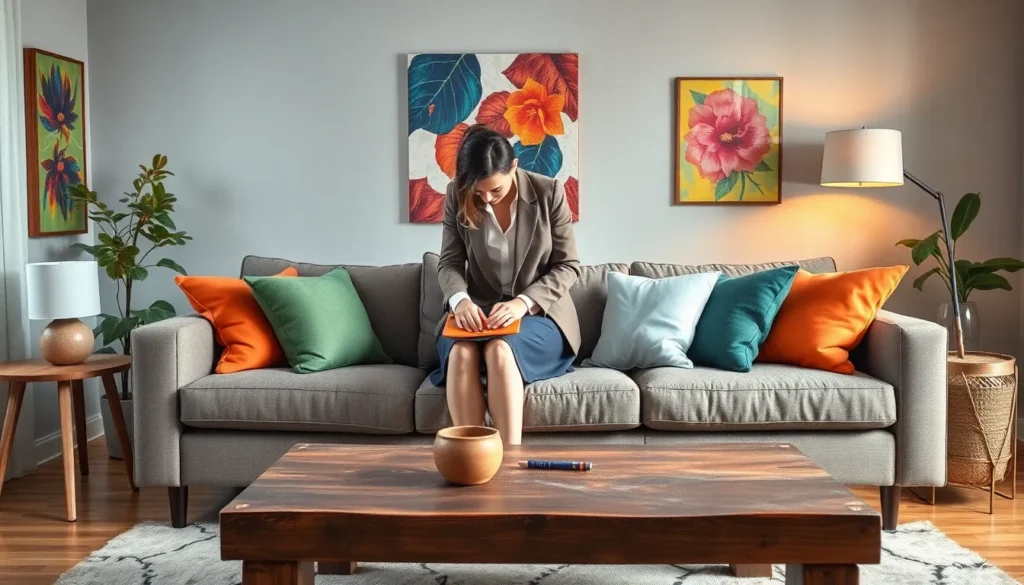Table of Contents
ToggleTransforming a living room into a stylish sanctuary isn’t just about throwing a few cushions on the couch. It’s an art form that blends comfort with creativity, and let’s face it, nobody wants to live in a space that looks like a tornado hit a thrift store. Whether you’re channeling your inner minimalist or embracing maximalism with wild abandon, the right design choices can make all the difference.
Understanding Interior Design for Living Rooms
Effective interior design for living rooms creates a welcoming atmosphere and enhances functionality. Balancing aesthetics with comfort fosters a space for relaxation and social interaction.
The Importance of Living Room Design
Living room design plays a critical role in defining a home’s character. A well-designed living room serves as a central gathering place for family and friends, promoting a sense of unity. Interior design impacts the overall mood and environment, influencing how occupants feel and interact. Thoughtful design choices can increase the home’s value, making it more attractive to potential buyers. The living room’s design also showcases personal style and preferences, reflecting individuality while meeting practical needs.
Key Elements of Living Room Interior Design
Key elements of living room interior design include color, furniture, and lighting. Color selection influences emotions and sets the ambiance, guiding choices toward warm or cool palettes. Furniture arrangement maximizes space, ensuring that movement remains unobstructed while promoting conversation. Lighting enhances functionality, combining natural light, ambient fixtures, and task lighting to create an inviting environment. Accessories such as rugs, curtains, and artwork add depth and character, allowing for personal expression. Storage solutions play a vital role, keeping the area organized and clutter-free.
Popular Styles in Living Room Design

Various styles dominate living room design, each offering unique aesthetics and functionality. Homeowners often choose styles based on personal preference and the atmosphere they want to create.
Modern Minimalism
Modern minimalism emphasizes simplicity and functionality. Furnishings feature clean lines and neutral colors, creating a serene environment. Accessories are few but carefully selected, ensuring a clutter-free space. Large windows often invite natural light, enhancing the overall openness of the room. This style promotes a sense of calm, making it ideal for relaxation.
Traditional Elegance
Traditional elegance showcases classic furnishings and rich materials. Ornate details on furniture complement muted color palettes, imparting a timeless feel. Decor often includes antique pieces, evoking a sense of history and warmth. Layered textiles, such as thick curtains and plush rugs, enhance comfort while accentuating the traditional theme. This style fosters a welcoming atmosphere, perfect for inviting gatherings.
Eclectic Approaches
Eclectic approaches embrace diversity and creativity. Mixing different styles and textures produces a vibrant personality in the living space. Bold colors and varied patterns create visual interest, often reflecting the homeowner’s travels or personal experiences. Furniture selection frequently includes standout pieces alongside traditional items, creating an inviting atmosphere. This style encourages self-expression, making every room unique.
Color Schemes and Textures
Color schemes and textures play a significant role in shaping the living room’s atmosphere. Selecting the right combinations can enliven the space, making it feel inviting and cohesive.
Choosing the Right Color Palette
Establishing a color palette sets the foundation for the living room’s aesthetic. Neutral shades promote calmness and versatility, enhancing various decor styles. Bold hues, such as deep blues or vibrant reds, inject personality and drama into the space. Consider using complementary colors for visual interest, ensuring harmony throughout the room. Additionally, incorporate accent colors through accessories, pillows, and artwork to create focal points and add layers. Testing paint samples on the walls before finalizing the choice helps visualize the overall effect in different lighting scenarios.
Incorporating Textures for Depth
Adding textures brings warmth and dimension to the living room. Layering materials, such as soft textiles, sleek metals, or rustic wood, creates a rich visual experience. Fabrics like velvet or linen for upholstery contribute a tactile experience that invites comfort. Natural elements, such as stone or clay, enhance organic appeal and ground the design. Using various textures also promotes interest and reflects the homeowner’s personality. Incorporating textured cushions, rugs, and throws achieves a balanced and inviting environment, encouraging a sense of connection and relaxation.
Furniture Selection and Arrangement
Selecting and arranging furniture can significantly impact a living room’s functionality and aesthetic appeal. Intentional choices enhance comfort and style, helping to create a cohesive environment.
Essential Furniture Pieces
Key furniture pieces include sofas, chairs, and coffee tables. Sofas serve as the room’s central element, providing comfort and seating for gatherings. Chairs, whether accent or lounge, offer versatility and can complement the sofa design. Coffee tables work as functional surfaces for drinks or decor, adding to the room’s overall appeal. Side tables also provide convenience, allowing for easy access to items like books or lamps. For additional seating, consider ottomans or poufs, which can double as decorative accents.
Tips for Optimal Furniture Arrangement
Strategic furniture arrangement can transform space despite its size. Start by defining the focal point, whether it’s a fireplace or a striking piece of art. Position sofas to encourage conversation, keeping an appropriate distance for comfort. Avoid overcrowding pathways to enhance flow within the living room. Place coffee tables within reach of seating to maintain accessibility. Layering rugs can also demarcate different areas, promoting intimacy or utility depending on the room’s layout. Finally, ensure adequate lighting by balancing natural and artificial sources, enhancing both ambiance and functionality.
Personalizing Your Living Room
Personalizing a living room creates a unique space that reflects individual style. Carefully selected elements make a significant impact on the room’s overall atmosphere.
Adding Personal Touches
Incorporating family photos fosters a sense of connection in the living room. Personal memorabilia adds character, inviting storytelling and shared memories. Choosing unique accessories, such as handmade items or souvenirs from travels, brings charm. Incorporating color-coordinated throw pillows or blankets offers comfort and warmth. Select items that resonate with personal experiences to build a cohesive look. Curating a mix of decorative pieces, like books or antique finds, adds depth to the design while showcasing individual interests.
Incorporating Art and Decor
Art serves as a focal point, enhancing the visual appeal of the living room. Curating pieces that inspire or evoke emotions creates an engaging environment. Wall art, whether framed or as a gallery, invites conversation and admiration. Selecting sculptures or decorative objects adds a three-dimensional dimension to the space. Opting for vibrant pieces infuses energy, while subtle hues promote tranquility. Layering decor elements, like candles or vases, creates visual interest and balance throughout the room.
Transforming a living room into a stylish and inviting space requires careful consideration of design elements and personal touches. By blending creativity with intentional choices, homeowners can create a sanctuary that reflects their unique style while enhancing functionality.
Whether embracing modern minimalism or traditional elegance, each design style offers an opportunity to craft a space that fosters connection and relaxation. Thoughtful selections in color, furniture arrangement, and decor not only elevate the room’s ambiance but also contribute to the home’s overall character.
Ultimately, a well-designed living room serves as a backdrop for cherished memories and gatherings, making it an essential part of any home.




